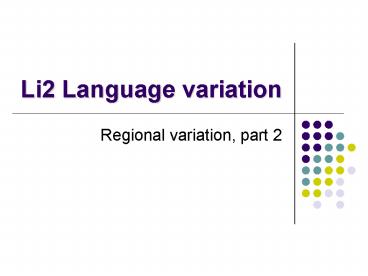Li2 Language variation - PowerPoint PPT Presentation
1 / 29
Title:
Li2 Language variation
Description:
Scandinavian toponyms most common in Yorkshire and Lincolnshire 600 in -by ... Illusion that TV is homogenizing language Walt Wolfram in American Tongues: ... – PowerPoint PPT presentation
Number of Views:151
Avg rating:3.0/5.0
Title: Li2 Language variation
1
Li2 Language variation
- Regional variation, part 2
2
Todays topics
- How do dialects develop?
- The current state of dialectology
3
How do dialects develop?
- settlement history (cont. from last week)
- the challenge of language acquisition
- semantic differentiation (see next slide)
- invasions and other localized influences
- Danelaw
- Norman Conquest
- boundaries
- political, geographic, transport, etc.
4
- Place names around Boston, MA
- (inspired by Chambers and Trudgill 1998174)
5
Synonymy Avoidance
- Anecdotal evidence
- Children say things like Thats not a car, its a
taxi. - Markmann Effect
- show child pair of pewter tongs and call it biff,
child interprets biff as tongs in general when
asked for more biffs, it picks out plastic tongs. - If shown a pewter cup called biff, child assumes
it means pewter, not cup, since it already has a
word for cup. When asked for more biffs, the
child chooses pewter spoon or pewter tongs. - Many dialect manifestations, including
- cookies (choc chip? big?), fries (McDs?)
- hundreds and thousands
Markman, Ellen. 1989. Categorization and naming
in children problems in induction. Cambridge,
Mass. MIT Press.
6
What constitutes a jimmy? Is it defined by shape
or color? I think sprinkles are small colored
balls and jimmies are small colored or brown
cylinders. Paul thinks sprinkles are small
colored balls or cylinders and jimmies are just
the brown cylinders.
7
Invasions
8
The Danelaw
- Norsemen began invading England in 793
- Following their defeat by Alfred the Great at the
battle of Ethandun (878), they withdrew to the
north - Treaty of Wedmore (886) Danes agree to settle
only in the northeast third of the country, which
is subject to Danish law and hence called the
Danelaw. - 991 Danes invade the south again, force Æthelred
into exile, seize the throne, and rule England
for 25 years.
9
Scandinavian toponyms
- most common in Yorkshire and Lincolnshire
- 600 in -by (Scandinavian farm, town)
- most of the remainder
- -thorp village
- -thwaite clearing
- -toft homestead
- Crystal, David. 1997. Cambridge encyclopedia of
the English language. CUP.
10
The Danelaw
- ON gaukr cuckoo
SNIPE (Gallinago gallinago) Local name Horse
Gowk Orkney (Islands) http//www.westray-orkney.c
o.uk/nhbirdbreeders.html
11
The Danelaw
- Danelaw (9th C)
- bairn child (ON barn)
- gimmer-lamb newborn female sheep (ON gymbr)
- beck any running water smaller than a river (ON
bekkr) - to lake to play (ON leika)
12
Norman influence
- animal
- cow (Kuh)
- sheep (Schaf)
- calf (Kalb)
- chicken
- food
- beef (boeuf bovine, ox, beef)
- mutton (mouton sheep)
- veal (veau calf)
- poultry (Fr. poulet chicken)
13
Norman influence
- Cf. French automne
14
Norman influence
- What do you call the animal with the prickly back
that rolls itself up when frightened? - 1 hedgehog
- 2 urchin (OF herichon)
- other variants
- hedge-boar
- prick-urchin
- prick(l)y-b(l)ack-urchin
15
Physical boundaries
16
Physical boundaries 1BrE vs AmE
asymmetry in intelligibility?
17
Physical boundaries 2
food trough in a cow-house
18
Correlation with cultural boundariesThe western
NY boundary
- Finger Lakes
- Phelps-Gorham Purchase, 1788
- Buffalo (wNY) vs. NYC (vs. upstate NY)
- Erie Canal/Great Lakes, TV ranges, Bills vs.
Giants
New York State Association of Municipal
Purchasing Officials www.nysampo.org/chapters/samp
o/regionmap.cfm
19
Messy boundaries 1
- Dialect boundaries are not always so neat or
sensible
- Chambers, Jack and Peter Trudgill. 1998.
Dialectology. CUP. p. 6. - http//encyclopedia.quickseek.com/images/FrancLowU
pperHigh.PNG
20
Messy boundaries 2
- Harvard Survey Q59. What do you call the game
wherein the participants see who can throw a
knife closest to the other person (or
alternately, get a jackknife to stick into the
ground or a piece of wood)? (10689 respondents) - I have never heard of this "game" and have no
idea what it's called (51.32) - mumbly peg (10.84)
- mumbledy-peg (8.69)
- mumblety-peg (8.07)
- chicken (2.94)
- Russian roulette (1.90)
- mumblely peg (with 2 l's) (1.81)
- stretch (1.14)
- stick-knife (1.01)
- splits (0.49)
- mumbly pegs (0.47)
- mumble peg (0.23)
- numblety peg (0.22)
- baseball jackknife (0.16)
- stick-frog (0.16)
- knifey (0.11)
- mummety-peg (0.02)
- peggy (0.02)
21
The current state of dialectology
22
Fricative voicing in SW England
23
Traditional isoglosses (Kurath 1949)
whiffletree
whippletree
- Representative isoglosses showing the boundaries
of the North, Midlands, and South of the US - whiffletree, whippletree swingletree
- sook! a cow call
- lightwood kindling
Sook!
lightwood
24
Multidimensional scaling
- With Lifeng Zhu, Centre of Chemometrics,
University of Bristol
25
Extracting sense
- Statistical analysis over multiple variables can
reveal larger patterns
26
Corpus searches wop(atui)
27
Googlenewsginnel
28
Are dialects disappearing?
- Illusion that TV is homogenizing language
- Walt Wolfram in American Tongues kids pay more
attention to their peers than to TV - Labov 1994 dialect diversity is increasing
- Cf. covert prestige and WC Glasgow males
29
Conclusions
- Dialect differentiation has roots in a
combination of historical, geographic, and
cognitive sources. - These factors often trump forces of
standardisation - Linguistics at nexus of humanities, sciences,
social sciences - Dialectology need not be restricted to NORMs and
outdated methods - Telephone and internet surveys and corpus
searches are yielding promising results,
especially in tandem with new mapping and
statistical techniques






























